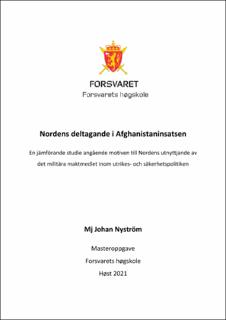| dc.description.abstract | Norden består av småstater med en begränsad möjlighet att påverka sin ställning inom de internationella relationerna. Istället måste de söka understöd hos större stater. Norden har samtidigt en diversifierad utrikes- och säkerhetspolitik, samt olika intressen med hänsyn till individuella geopolitiska förutsättningar.
Syftet med denna studie är att med Graham T. Allisons Rational Actor Model (RAM) testa hur de nordiska staterna förhåller sig till situationen, samt hur respektive försvarsmakt har utnyttjats för att skapa bättre förutsättningar för statens överlevnad och tillvaratagande av intressen.
Resultatet indikerar att samtliga stater under perioden 1990-2001, i eget tempo och omfattning, ställde om respektive försvarsmakt från ett invasions- till insatsförsvar med avsikt att bättre kunna stödja bl.a. USA vid internationella insatser. Därigenom blev det militära maktmedlet ett accepterat och legitimt verktyg inom utrikes- och säkerhetspolitiken. Drivkraften för processen har varit önskan om goda förbindelser med internationella organisationer såsom EU, Nato och särskilt USA, som följd av den unipolära maktfördelningen inom de internationella relationerna.
Avsikten med insatserna hade ytterst sitt ursprung i faran för minskad relevans och marginalisering av andra stater och särskilt USA. Gränssättande för tempot och omfattningen av försvarets omställning var det upplevt hot från Ryssland. Danmark, samt Sverige, uppfattade hotbilden som låg och genomförde en mer ingripande omställning. Medan Finland och Norge, som är gränsstater med Ryssland, gjorde skilda bedömningar. Norge genomförde en omställning, medan Finland endast en partiell reformation. För Norge blev möjligheterna till en reciprok behandling av USA gränssättande, och försvaret intog därför dubbla roller, medan Finland förlitade sig till fullo på sitt invasionsförsvar. | en_US |
| dc.description.abstract | The Nordic region is divided into small states with a limited possibility to govern their own position within the international community. Instead, they have to seek support from larger states. At the same time, the Nordic states have a diversified foreign and security policy, due to variated interests, because of individual, and differentiated geopolitical conditions.
The objective of this study was to test how the Nordic states relate to the described situation using Graham T. Allison's Rational Actor Model (RAM), applied to their decision making regarding participation in the Afghanistan military mission. In addition, I intended to study how the Nordic Armed Forces were affected, with the objective to create better conditions for the state's survival and safeguarding of interests.
The result indicates that all states, between the period 1990-2001, at their own pace and scope, reformed their armed forces from an territorial posture to developing expeditionary capabilities, with the intention of providing better support to the EU, Nato, and especially the USA, during international military operations. In this way, the military instrument of power became an accepted and legitimate tool in their foreign and security policy, respectively. The driving force behind the process was the desire for maintaining, and increasing, good relations with international community, such as the EU, NATO and especially the US, as a consequent of the unipolar distribution of power within international relations. The intention of their efforts ultimately originated in the danger of becoming less relevant and marginalized by other states and in particular the US.
The perceived threat from Russia, became a limiting factor for the pace and scope of the defense transformation, separately. Denmark, as well as Sweden, perceived the threat as low, and carried out a more thorough adjustment. While Finland and Norway, who were directly neighboring Russia, equally felt uneasy about the border situation, however, made different choices regarding their defense transformation. Norway shifted from a territorial defense to an expeditionary style, like Sweden and Denmark, with the intention to gain higher reciprocity from their US support, but never entirely abandoned the territorial focus. In the meanwhile, Finland only made partial adjustments and kept the territorial defense in full. | en_US |
